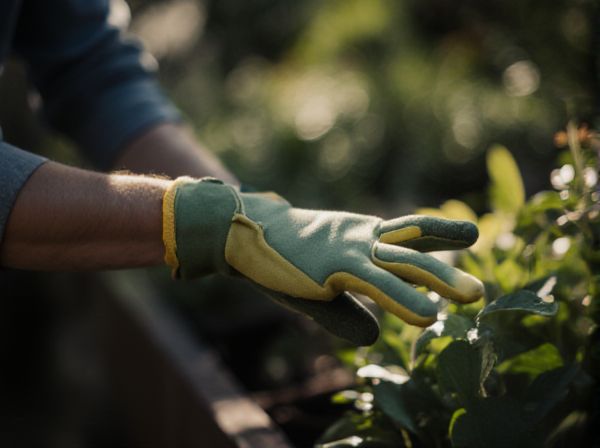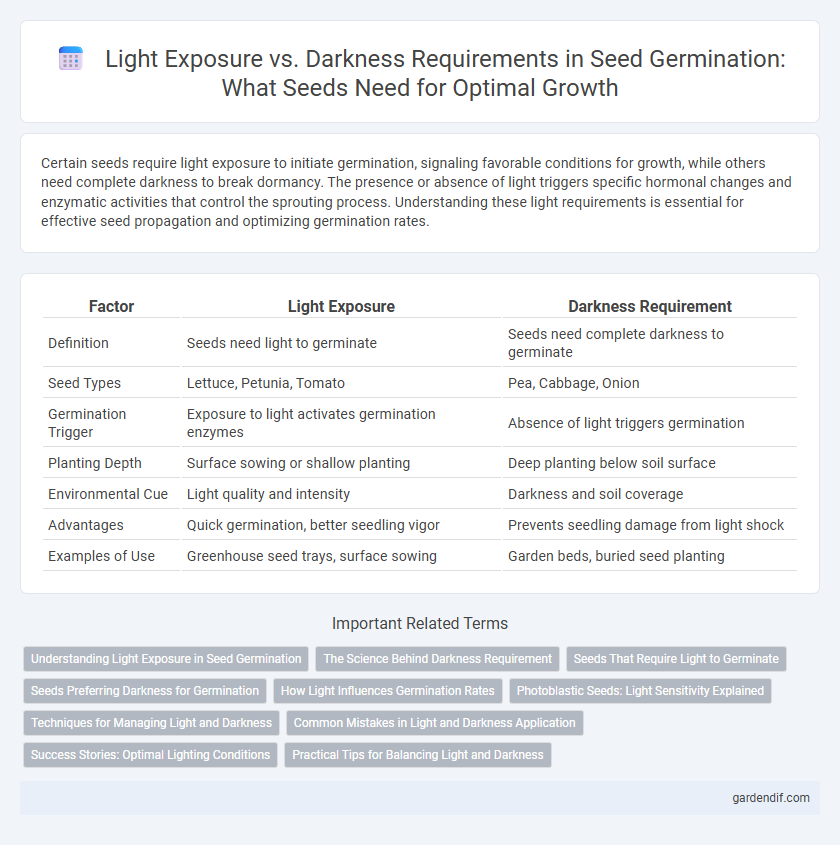
Light Exposure vs Darkness Requirement Illustration
Certain seeds require light exposure to initiate germination, signaling favorable conditions for growth, while others need complete darkness to break dormancy. The presence or absence of light triggers specific hormonal changes and enzymatic activities that control the sprouting process. Understanding these light requirements is essential for effective seed propagation and optimizing germination rates.
Table of Comparison
| Factor | Light Exposure | Darkness Requirement |
|---|---|---|
| Definition | Seeds need light to germinate | Seeds need complete darkness to germinate |
| Seed Types | Lettuce, Petunia, Tomato | Pea, Cabbage, Onion |
| Germination Trigger | Exposure to light activates germination enzymes | Absence of light triggers germination |
| Planting Depth | Surface sowing or shallow planting | Deep planting below soil surface |
| Environmental Cue | Light quality and intensity | Darkness and soil coverage |
| Advantages | Quick germination, better seedling vigor | Prevents seedling damage from light shock |
| Examples of Use | Greenhouse seed trays, surface sowing | Garden beds, buried seed planting |
Understanding Light Exposure in Seed Germination
Light exposure plays a crucial role in seed germination by triggering hormonal changes that activate growth processes. Certain seeds require light (positive photoblastic seeds) to break dormancy, while others germinate best in darkness (negative photoblastic seeds), demonstrating species-specific light sensitivity. Understanding these light germination responses aids in optimizing agricultural practices and improving seedling establishment.
The Science Behind Darkness Requirement
Certain seeds require darkness to trigger germination, as exposure to light can inhibit the process by affecting the phytochrome system, a photoreceptor that regulates seed germination. In these seeds, the inactive form of phytochrome (Pr) accumulates in darkness, signaling optimal environmental conditions for growth. This biological mechanism ensures seeds germinate only when buried beneath soil or leaf litter, protecting seedlings from harsh light and environmental stress.
Seeds That Require Light to Germinate
Seeds that require light to germinate often belong to small-seeded species like lettuce, petunias, and impatiens, which rely on light as a trigger for the germination process. These photoblastic seeds sense specific wavelengths through phytochrome receptors, initiating hormonal changes that promote embryo growth only when exposed to adequate light. Germination rates significantly increase under red light exposure, while darkness inhibits these light-dependent seeds, ensuring they only sprout at or near the soil surface for optimal survival conditions.
Seeds Preferring Darkness for Germination
Seeds preferring darkness for germination, such as lettuce and pansy, require minimal light exposure to trigger sprouting processes efficiently. These seeds often possess photoreceptors sensitive to light inhibition, ensuring germination occurs under soil cover or shaded conditions. Darkness promotes hormonal balance favoring gibberellin activation and abscisic acid suppression, critical for initiating seedling development.
How Light Influences Germination Rates
Light exposure significantly impacts germination rates by activating photoreceptors that trigger hormonal changes essential for seed sprouting. Certain seeds require light to break dormancy, as it stimulates the production of gibberellins, promoting embryo growth. Conversely, other seeds germinate better in darkness, where the absence of light prevents inhibition pathways, illustrating the complex role of light in seed germination biology.
Photoblastic Seeds: Light Sensitivity Explained
Photoblastic seeds exhibit sensitivity to light, which significantly influences their germination rates. Positive photoblastic seeds require exposure to specific light wavelengths, often red light, to trigger germination, whereas negative photoblastic seeds germinate best in darkness or under far-red light conditions. Understanding the phytochrome system, which mediates these light responses, allows for optimized seed germination protocols in agriculture and horticulture.
Techniques for Managing Light and Darkness
Effective germination techniques involve controlling light exposure by using opaque covers or placing seeds in dark environments to promote growth for species requiring darkness. For light-sensitive seeds, employing transparent containers or using artificial light sources ensures optimal light intensity and duration. Adjusting light conditions based on specific seed requirements enhances germination rates and seedling vigor.
Common Mistakes in Light and Darkness Application
Common mistakes in germination related to light exposure include exposing seeds that require darkness to light, which inhibits sprout development and reduces germination rates. Ignoring species-specific light requirements often results in poor seedling emergence and weak plant growth. Ensuring accurate application of light or darkness conditions based on seed type is crucial for optimizing germination success.
Success Stories: Optimal Lighting Conditions
Seeds of lettuce, petunias, and tomatoes exhibit higher germination rates under specific light exposure, demonstrating the importance of optimal lighting conditions for seedling success. Studies reveal that lettuce seeds require light for germination, while tomato seeds germinate effectively in both light and darkness, emphasizing species-specific lighting needs. These success stories underscore the role of controlled light environments in enhancing germination efficiency across various plant species.
Practical Tips for Balancing Light and Darkness
Optimal germination requires careful control of light exposure, as some seeds need light to trigger sprouting while others germinate best in darkness. Use translucent covers to provide diffuse light without direct exposure, and monitor seed packets or species-specific guides for precise light requirements. Rotating trays between light and dark areas can help balance conditions, ensuring consistent moisture and temperature during the critical germination phase.
Light Exposure vs Darkness Requirement Infographic

 gardendif.com
gardendif.com